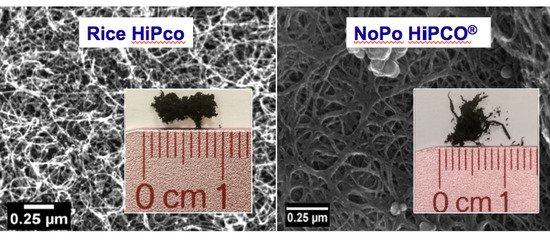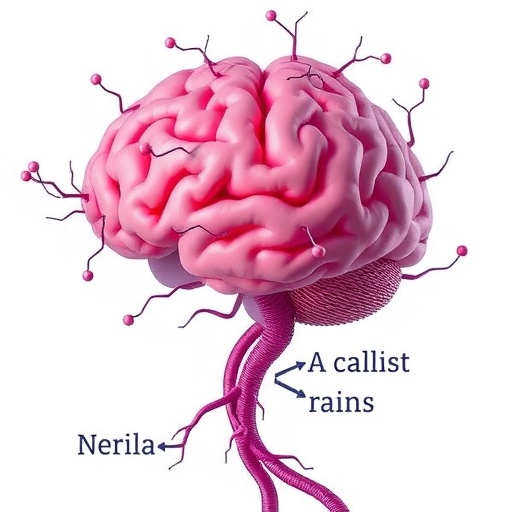
Credit: Energy Safety Research Institute, Swansea University
A new method of producing carbon nanotubes – tiny molecules with incredible physical properties used in touchscreen displays, 5G networks and flexible electronics – has been given the green light by researchers, meaning work in this crucial field can continue.
Single-walled carbon nanotubes are among the most attractive nanomaterials for a wide range of applications ranging from nanoelectronics to medical sensors. They can be imagined as the result of rolling a single graphene sheet into a tube.
Their properties vary widely with their diameter, what chemists call chirality – how symmetrical they are – and by how the graphene sheet is rolled.
The problem faced by researchers is that it is no longer possible to make high quality research samples of single-walled carbon nanotubes using the standard method. This was associated with the Carbon Center at Rice University, which used the high-pressure carbon monoxide (HiPco) gas-phase process developed by Nobel Laureate, the late Rick Smalley.
The demise of the Carbon Center in the mid-2010s, the divesting of the remaining HiPco samples to a third-party entity with no definite plans of further production, and the expiration of the core patents for the HiPco process, meant that this existing source of nanotubes was no longer an option.
Now however, a collaboration between scientists at Swansea University (Wales, UK), Rice University (USA), Lamar University (USA), and NoPo Nanotechnologies (India) has demonstrated that the latter’s process and material design is a suitable replacement for the the Rice method.
Analysis of the Rice “standard” and new commercial-scale samples show that back-to-back comparisons are possible between prior research and future applications, with the newer HiPco nanotubes from NoPo Nanotechnologies comparing very favourably to the older ones from Rice.
These findings will go some way to reassure researchers who might have been concerned that their work could not continue as high-quality nanotubes would no longer be readily available.
Professor Andrew Barron of Swansea University’s Energy Safety Research Institute, the project lead, said:
“Variability in carbon nanotube sources is known to be a significant issue when trying to compare research results from various groups. What is worse is that being able to correlate high quality literature results with scaled processes is still difficult”.
Erstwhile members of the Smalley group at Rice University, which developed the original HiPco process, helped start NoPo Nanotechnologies with the aim of updating the HiPco process, and produce what they call NoPo HiPCO® SWCNTs.
Lead author Dr. Varun Shenoy Gangoli stated:
“It is in the interest of all researchers to understand how the presently available product compares to historically available Rice materials that have been the subject of a great range of academic studies, and also to those searching for a commercial replacement to continue research and development in this field.”
The new study appears in the open-access MDPI journal C.
###
Picture:
Comparison of single walled carbon nanotubes: on the left, produced by Rice University HiPco method, and on the right, produced by NoPo HiPco method. Microscope image of each (scale bar = 0.25 μm) with photograph.
Notes to editors:
About the article: Dr Varun Shenoy Gangoli is a research scientist in the Chemistry Department at Rice University. Co-authors of this work are Anto Godwin, Gadhadar Reddy of NoPo Nanotechnologies, and Robert Kelley Bradley of Lamar University. Prof Andrew Barron is the Sêr Cymru Chair of Low Carbon Energy and Environment, and Director of ESRI at Swansea University and professor emeritus of chemistry, materials science and nanoengineering at Rice.
The Office of Naval Research and the Welsh Government Sêr Cymru National Research Network in Advanced Engineering and Materials supported the research.
Read the abstract and full text at https:/
Follow ESRI via Twitter @ESRI_Swansea
- ESRI: http://www.
esri-swansea. org/ en/ - Swansea University: http://www.
swansea. ac. uk/ - Rice University: https:/
/ www. rice. edu/
Swansea University is a world-class, research-led, dual campus university offering a first class student experience and has one of the best employability rates of graduates in the UK. The University has the highest possible rating for teaching – the Gold rating in the Teaching Excellence Framework (TEF) in 2018 and was commended for its high proportions of students achieving consistently outstanding outcomes.
Swansea climbed 14 places to 31st in the Guardian University Guide 2019, making us Wales’ top ranked university, with one of the best success rates of graduates gaining employment in the UK and the same overall satisfaction level as the Number 1 ranked university.
The 2014 Research Excellence Framework (REF) 2014 results saw Swansea make the ‘biggest leap among research-intensive institutions’ in the UK (Times Higher Education, December 2014) and achieved its ambition to be a top 30 research University, soaring up the league table to 26th in the UK.
The University is in the top 300 best universities in the world, ranked in the 251-300 group in The Times Higher Education World University rankings 2018. Swansea University now has 23 main partners, awarding joint degrees and post-graduate qualifications.
The University was established in 1920 and was the first campus university in the UK. It currently offers around 350 undergraduate courses and 350 postgraduate courses to circa 20,000 undergraduate and postgraduate students. The University has ambitious expansion plans as it moves towards its centenary in 2020 and aims to continue to extend its global reach and realise its domestic and international potential.
Swansea University is a registered charity. No.1138342. Visit http://www.
For more information:
Kevin Sullivan,Swansea University Public Relations Office
Tel: 01792 513245, [email protected]
Follow us on Twitter: http://www.
Find us on Facebook: http://www.
Media Contact
Kevin Sullivan
[email protected]





